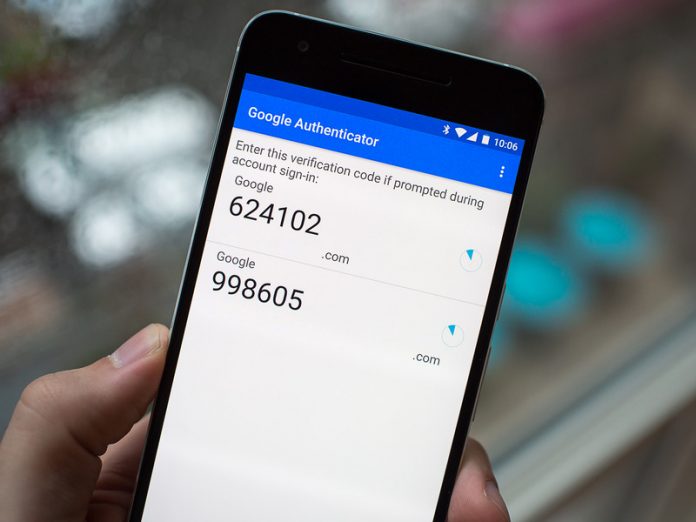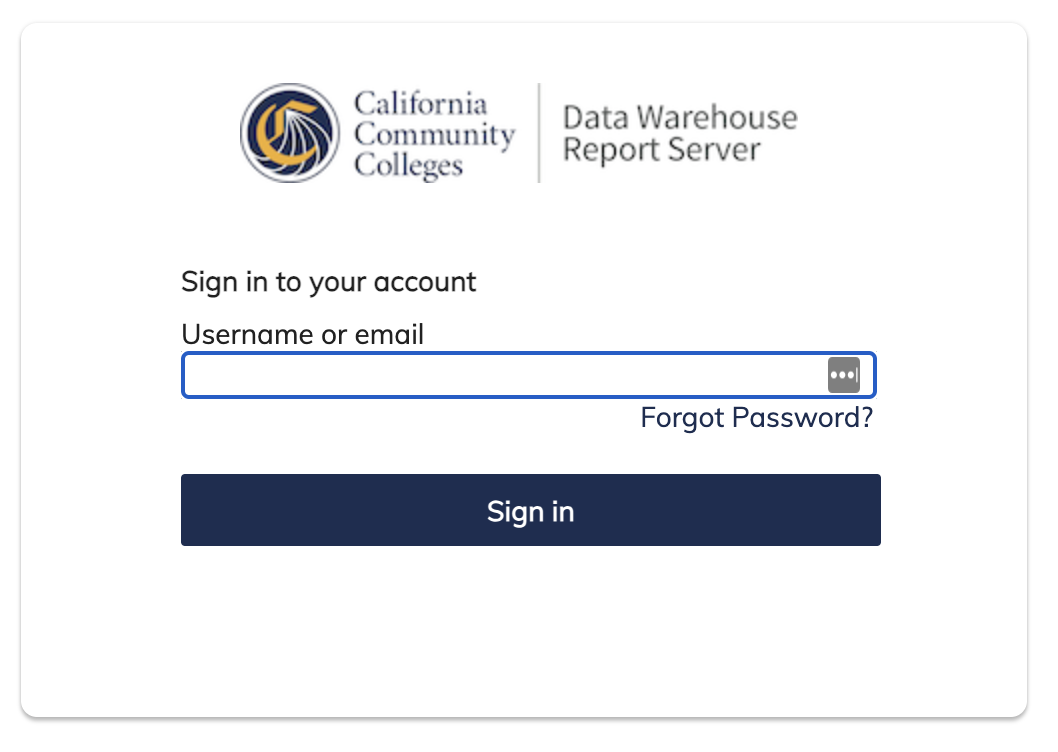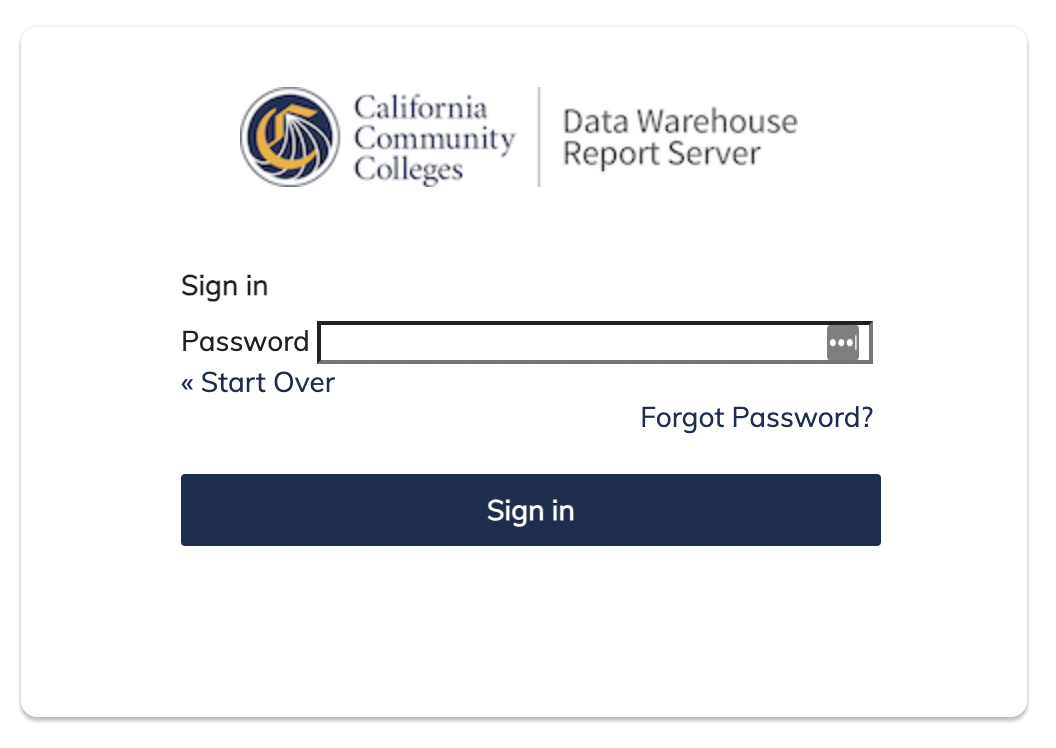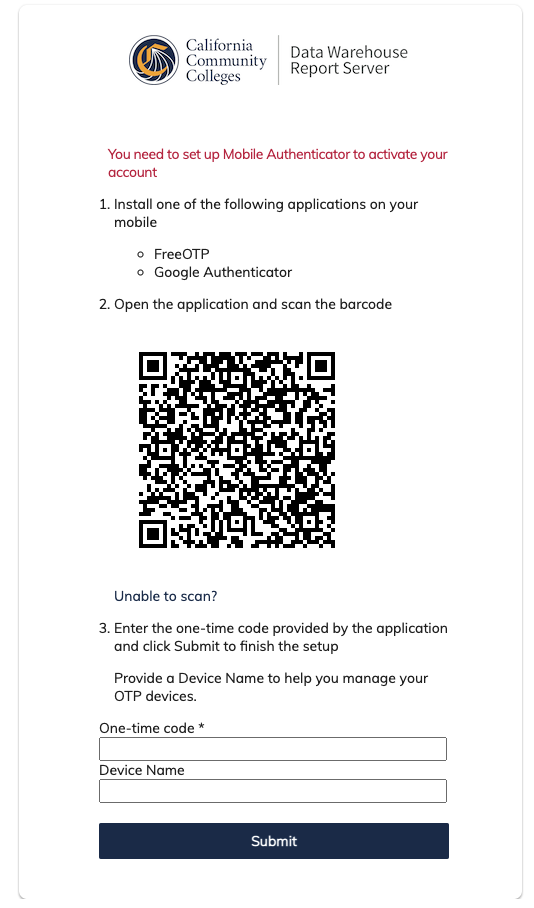...
...
...
...
...
...
...
...
...
...
...
...
...
...
| Panel | ||||||
|---|---|---|---|---|---|---|
| ||||||
This guide is for the Data Warehouse Report Server (CCC Data 2.25.0) released to production on January 27August 16, 2023. |
In This User Guide
| Table of Contents | ||||
|---|---|---|---|---|
|
| Panel | ||||||
|---|---|---|---|---|---|---|
| ||||||
Note: All hyperlinks in this document open in the same window. |
Part 1: Overview
The information provided in this document serves as a "Quick Start" guide for users of the CCC Data Warehouse Report Server (“DW Report Server”, “Report Server”, “DWRS”), including:
...
Access to the DW Report Server is restricted to authorized users to ensure the privacy and security of the data within the CCC Data Warehouse. Users must request access using via one of the appropriate processes below , and upon approval will be granted an account based on their user type.
...
Getting Started
Establishing an authorized DWRS user account is a two-part workflow between a CCCTC Administrator and the approved user. An Enabling Services Implementation Configuration Engineer (ICE) will create and configure the account in our internal system and then work with the user to complete the final steps and loginlog in, depending on the user type. This section of the document outlines the roles and responsibilities - and setup tasks - for the CCCTC Administrator and the approved DWRS user.
...
| Panel | ||||||
|---|---|---|---|---|---|---|
| ||||||
Contact your College Relationship Manager (CRM) from the CCCTC Enabling Services team to request authorized access or setup an approved account, today. |
User Accounts
Access to the DWRS requires an authorized user account configured based on user type. There are two types of authorized user accounts:
SSO Users: Colleges and Districts using their institution’s IDP for single sign-on. The institution’s login may include (CCCTC does not manage your institution’s two-factor authentication (2FA) , but this SSO mechanism is not managed by the CCCTC.mechanism, if implemented.)
Non-SSO Users: CCCCO, CVCOEI, and other authorized external users will authenticate directly to the DWRS using 2FA to secure and protect our systemwide student data.
...
| Panel | ||||||
|---|---|---|---|---|---|---|
| ||||||
College & District SSO Users: See Appendix A: Data Warehouse Report Server URLsfor your custom IdP URL. |
Set Up & Log In Processes
The process for account setup and login log in will be different depending on user type, access level, and the mechanism used to authenticate. Working with an Implementation & Configuration Engineer (ICE) from the CCCTC Enabling Services team to set up and configure your account, college & district users (SSO Users) will be are provided a custom URL configured to your institution’s institution MIS code and internal IdP link. Non-SSO Users will be directed to the DWRS directly to log in and complete URL to complete additional setup & verification tasks steps to facilitate authentication.
Below is an explanation of the setup process followed by summaries of the login process for each of the two authentication methods.
...
Prerequisites for All Users
Before a user can log into in to the DWRS the following conditions must be met:
The authorized user has followed the Getting Started tips above and has coordinated with CCCTC Enabling Services to begin the account creation setup and configuration process based on their user type and access level.
The account has been configured CCCTC Enabling Services has added and configured your account with the appropriate roles , and attributes, and - for SSO Users only - their institution’s IDP linkhas sent your account credentials via secure method.
SSO Users have received their Only: You have bookmarked your unique college or district DWRS URL, configured to their IDP, and know their your institution’s IdP single sign-on credentials provided to them by their (managed locally by your college or district’s district IT department).
Non-SSO Users Only: You have received their account credentials and your temporary password from a CCCTC Enabling Services Administrator,have installed the authentication app software, and have completed the “First-Time User Log In” process (setup and verification tasks) required to facilitate initiate two-factor authentication at the generic DWRS URL.
SSO Users: Account Setup & Log In Process
Colleges College & DistrictsDistrict Users
The User coordinates with the CCCTC Enabling Services
...
team to ensure their account is configured with the required roles, attributes, and
...
IDP
...
link.
The User is
...
provided the appropriate DWRS URL for their IDP and logs in.
The User is authenticated locally through their
...
institution’s IDP (SSO) and
...
logs in to the DWRS.
| Panel | ||||||
|---|---|---|---|---|---|---|
| ||||||
College & district user credentials are set by their institution IdP for single sign-on (SSO). These users should know their unique credentials or should contact their institution’s IT department to change or update themusers should contact their institution’s IT team for information on their local SSO credentials. These credentials are not managed by the CCCTC. |
Non-SSO Users: Account Setup & Log In Process
All Other Users
The User coordinates with the CCCTC Enabling Services
...
team
...
to get their temporary password and first-time log in information via secure method (i.e., Privnote).
The User downloads and installs
...
compatible authentication software on their desktop or mobile device.
The User completes the “First-time User Log In” process, which enables entry of account credentials, one-time QR code verification, and authentication to the DWRS.
Optional: After logging in, the User may update their temporary password using the Forgot Password? link to reset their password.
Receiving Your Secure Account Credentials
For security purposes, all non-SSO users will receive their account credentials and a temporary password in one or two separate emails from the an CCCTC Enabling Services Administrator. The email(s) will include a link to a secure Privnote message , sent to their the user’s institution email address (.edu).
| Panel | ||||||
|---|---|---|---|---|---|---|
| ||||||
Note: The password will not be passed to the authorized user until they have started initiated the implementation process with the CCCTC Enabling Services teamfor added security. |
Implementing the Authentication Software
...
| Expand | |||||||||||
|---|---|---|---|---|---|---|---|---|---|---|---|
| |||||||||||
To Install the Chrome Authenticator:
|
Google Authenticator App for Mobile Device
...
| Expand | |||||||||
|---|---|---|---|---|---|---|---|---|---|
| |||||||||
Google Authenticator is compatible with multiple different mobile devices, operating systems, and browsers. The process for downloading and installing can be found here.
|
| Panel | ||||||||
|---|---|---|---|---|---|---|---|---|
| ||||||||
Suggestion: Although any six-digit TOTP compatible authentication software should work for the Report Server User Account, the tools that we’ve found to be most user friendly are: Chrome Authenticator for desktop use and Google Authenticator for mobile devices. Both are free downloads and both can also be used together. |
| Panel | ||||||
|---|---|---|---|---|---|---|
| ||||||
NEXT: Start the “First-Time User Log In” process below to initiate the authentication process and log in. |
...
The First-Time User Log In Process
For Non-SSO Users Only: The first time a new non-SSO user attempts to log in to the DWRS they must establish the connection between their user account credentials, a shared secret key (QR Code), and the authentication software to enable the two-factor (2FA) login log in authentication.
Pre-requisitesPrerequisites:
The User has the Data Warehouse Report Server URL (httpDWRS direct access URL: (https://dw-reports.ccctechcenter.org/jasperserver-pro/login.html).
The User has received their account credentials and temporary password from the a CCCTC Enabling Services Administrator.
The User has installed and configured a compatible authentication software app on their desktop and/or mobile device.
| Expand | |||||||||||||||||||||||||||||||||||||
|---|---|---|---|---|---|---|---|---|---|---|---|---|---|---|---|---|---|---|---|---|---|---|---|---|---|---|---|---|---|---|---|---|---|---|---|---|---|
| |||||||||||||||||||||||||||||||||||||
Step 1: Enter Your Account Credentials on the Log InPagePages
Step 2: Scan the QR Code Page
|
...
For Non-SSO Users Only: After the user completes the one-time “First-Time User Log In” process, the user is “verified” and will not have to repeat the Scan the QR Code Page stepagain UNLESS they need to re-install their authentication software and/or generate a new QR code. For all subsequent loginss, the verified user needs only to enter their account credentials and the verification code retrieved from their authenticator app.
...
Step 1: Log in Page Enter Username or Email
Navigate to the Data Warehouse Report Server URL (httphttps://dw-reports.ccctechcenter.org/jasperserver-pro/) and land on the Log In page.login.html).
Enter your user account credentials and password username or institution’s email address in the input fields.
User ID: Enter your institutional email address in the User ID field (.edu, or org) (Required)
Password: Enter your unique Click the “Sign In” button.
field.
| Panel | ||||||
|---|---|---|---|---|---|---|
| ||||||
Tip: Your Username is your institution or organization email address used during the initial account setup with the CCCTC Enabling Services team. |
Step 2: Enter Password
Enter your password in the Password input field or click the Forgot Password? link to reset your password.
Click the “Sign In” button.
| Panel | ||||||||
|---|---|---|---|---|---|---|---|---|
| ||||||||
Reminder: Click the Forgot Password? link on the Log In page to recover your account password or to change your password at any time. |
Step 23: Enter Verification Code Page
...
Immediately upon landing on the “One-time code” screen, copy the verification code from your Authenticator app within 30 seconds of making the request (clicking on Sign In button on Log In screenafter entering password).
Verification Code: Enter the code from the authenticator app into verification code in to the “One-time code” field.Click the “Sign in” button to complete the log in process and access the DWRS. ” field.
Click the “Sign in” button to complete the process and access the DWRS.
| Panel | ||||||
|---|---|---|---|---|---|---|
| ||||||
Best Practice: To save time retrieving your verification code, consider labelling the DWRS entry in your Authenticator tool, especially if you are using the tool for more than one application. |
Password Reset Process
To change or update your account password:
Navigate to the Data Warehouse Report Server at https://dw-reports.ccctechcenter.org/jasperserver-pro/login.html.
Click the “Forgot Password?” link which is available on every screen.
...
Enter your email address that was used to create your account.
Click Submit.
...
A confirmation message appears on the screen directing you to retrieve an email.
...
4. Open the Reset Password email, click the embedded link to go to the Update Password page.
...
Enter your new password in the New Password box. Confirm your new password, then click Submit to return to the Sign In page.
...
Email Address Update Process
DWRS user accounts require a unique email address that identifies the user in the CCCTC secure identity management system. To change or update the email address associated with your account, please contact the CCCTC Support team to update the email address manually in the system. With verbal confirmation that the change has been made, the user should return to the Data Warehouse Report Server Sign In page to repeat the sign in process.
User Type | Authentication | Update Email Address | Update Password | |
College User | SSO User | SSO access via college/district IdP | Contact your college/district IT Dept | |
District User | SSO User | SSO access via college/district IdP | Contact your college/district IT Dept | |
Chancellor's Office User | Non-SSO User | Direct access (non-IdP) via two-factor authentication (2FA) | Use the self-serve Forgot Password? process | |
CVCOEI User | Non-SSO User | Direct access (non-IdP) via two-factor authentication (2FA) | Use the self-serve Forgot Password? process | |
CCCTC Administrator | Non-SSO User | Direct access (non-IdP) via two-factor authentication (2FA) | Use the self-serve Forgot Password? process | |
...
Appendix A: Data Warehouse Report Server URLs
| Panel | ||||||
|---|---|---|---|---|---|---|
| ||||||
Click here for college and district-specific Data Warehouse Report Server URLs. |
...
Part 3: Using the Report Server
...
On the Home page, click Create in the Reports block. The Create Report wizard opens.
Select the Ad Hoc view you want to use as the basis for your report.
Select a report template. To use a template other than the default, select Custom Report Template, click Browse and select the desired template. See Report Templates for more information.
Click OK. If asked, enter the input controls needed. See Using Input Controls.
...
| Panel | ||||||
|---|---|---|---|---|---|---|
| ||||||
See the online help topic under the Reports workflow View tutorial link. At around the 3:35 mark the tutorial begins to demonstrate scheduling a report. |
...
Part 4: Creating Custom Ad Hoc Views & Reports
...
Click the chart icon in the tool bar in the Ad Hoc Editor to display the “Select Visualization Type” dialog box.
Click on the Table icon - or your preferred type - to highlight your selection.
Click the “Apply and Close” button to save your change.
...
Working with Tables
This section explains how to populate, edit, and format your table type report view, including:
...
| Panel | ||||||
|---|---|---|---|---|---|---|
| ||||||
For more reportformatting tips, such as managing column sizes and adding spacing to your table-type report, see Working With Tables section of the JasperReports Server v7 User Guide. |
...
| Panel | ||||||
|---|---|---|---|---|---|---|
| ||||||
Creating Filters with Relative Dates You can filter information in your view based on a date range relative to the current system date. You can accomplish this using date-based filters, and entering a text expression describing the relative date or date span you want to display, using the format <Keyword>+/-<Number> where:
For example, if you want to see all of the CC Promise Grant Applications submitted during the prior week, your expression would be: WEEK-1. |
Steps to create a relative date filter:
Following the instructions in Using Filters, create a filter based on a date field. The filter appears in the Filters panel.
...
General Best Practice | Example |
View/Report Organization |
|
When Creating a View by Copying an Existing View |
|
...
Creating New Ad Hoc Reports
There are two ways to create a new custom or customize a report:
| Panel | ||||||
|---|---|---|---|---|---|---|
| ||||||
This section may reference features and functionality covered in the Working with the Ad Hoc Editorand the Working with Tables sections. Please refer to |
...
those sections as needed. |
Copy and Customize An Existing Report View
...
| Note |
|---|
Important: To make a change to a saved Report, you must make the change to its original View in the Ad Hoc Editor. |
Copy Steps:
Log in to the Data Warehouse Report Server.
Locate the View file that you want to copy from a folder in the Repository, or in the Library, and click on it.
Copy: With the file name highlighted, copy it using one of the following methods:
Click the Copy button in the tool bar.
Right-click the file name and select Copy from the context menu.
Paste the copy into a folder available to you in the Repository (one of your college or district organization folders).
...
| Panel | ||||||
|---|---|---|---|---|---|---|
| ||||||
You can now customize your new View copy as desired, and save it with a new name. See more Save & Export options below. |
Customize & Save View Steps:
Locate the new file you just copied, and click on it. Click the Open button. The View will open in the Ad Hoc Editor.
If desired, you can customize the new View you just copied or saved by using the functional controls in the Ad Hoc Editor. Customization options include:
Add or remove data Columns to your format
Add or remove Groups to your format
Add or remove Filters to further analyze your data
Reorder the columns by dragging the tabs in the Columns or Groups rows.
See the Working with Tables section above for help using the functionality in the Ad Hoc Editor.
When you are ready to save your new View, hover over the Save icon in the tool bar to display the menu options available.
Select Save Ad Hoc View As...
When the Save As dialog box displays:
Edit the Data View Name (required).
Edit the Data view Description field (optional).
Scroll through the list of available Organizations folders to select which folder you want to save your college's report View.
Click Save.
...
| Panel | ||||||
|---|---|---|---|---|---|---|
| ||||||
Review the section The Ad Hoc Editorsectionabove to revisit the components and functionality of the Ad Hoc Editor |
...
| Panel | ||||||
|---|---|---|---|---|---|---|
| ||||||
Reminder: In order to create a new ad hoc report, you must first design the report in the Ad Hoc Editor and save it as a View. Then it can be saved and run as a report. |
Create New Ad Hoc View Steps:
Log in to the Data Warehouse Report Server.
From the main menu, select Create > Ad Hoc View to display the Select Data dialog box.
...
| Panel | ||||||
|---|---|---|---|---|---|---|
| ||||||
Data Warehouse-related specific data sources have contain a "DW" in the name of the source and "Topic" as a part of their name. |
...
| Note |
|---|
Before you begin adding fields, measures and other customization customizations to your new ad hoc View, select a view typefrom the “Select Visualization Type” dialog box. |
...
Support Using the Report Server
Contact College Support (staffsupportccctc@openccc.zendesk.com) to report technical issues with the Data Warehouse Report Server - or visit our online community support site , CCCTechnology.info.
| Panel | ||||||||
|---|---|---|---|---|---|---|---|---|
| ||||||||
For more help using the Data Warehouse Report Server, please refer to the onlineHelpdocumentation available from the provider TIBCO Jaspersoft. |
...
Part 5: Report Templates
The Data Warehouse Report Server is a structured source of master data that can be used to generate the reports, templates, data marts, and analytics that end-users need.
...
| Panel | ||||||
|---|---|---|---|---|---|---|
| ||||||
Helpful Tip: When saving the details of your custom Ad Hoc View and corresponding Report, keep the names and descriptions the same - or very similar - so you can identify the pair if you want to update your report in the future. Remember that every report is based on its original View, and if you want to change your report you need to make the changes in the corresponding View, and then save the changes as a new report. |







